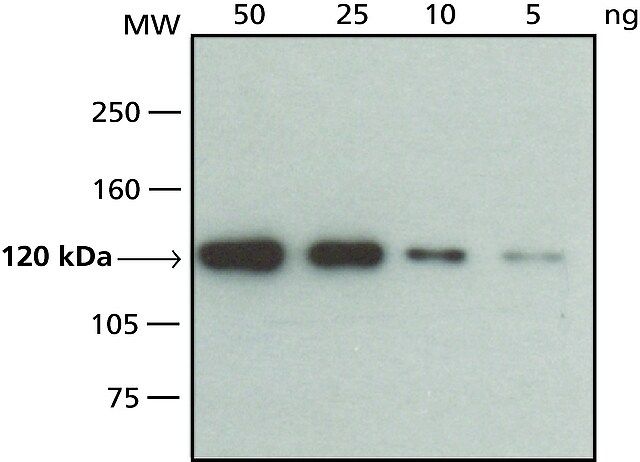您的位置:首页 > 产品中心 > 抗-VSV糖蛋白单克隆抗体
抗-VSV糖蛋白单克隆抗体
Anti-VSV-G-Peroxidase antibody, Mouse monoclonal

| 产品编号: | 3154440 |
| 规格: | 1.0-1.5 mg/mL, clone P5D4, purified from hybridoma cell culture |
| 包装规格: | 1 VIAL |
| 产品类别: | 进口试剂 |
| 品牌: | Sigma-Aldrich |
| 优惠价: | 立即咨询 |
产品别名
抗-VSV糖蛋白单克隆抗体
Anti-VSV-G-Peroxidase antibody, Mouse monoclonal
Monoclonal Anti-VSV Glycoprotein
基本信息
| NACRES | NA.56 |
| General description【一般描述】 | Monoclonal Anti-VSV-G-Peroxidase is a lyophilized preparation of the purified immunoglobulin fraction of monoclonal Anti-VSV-G (mouse IgG1 isotype) isolated from ascites fluid of the P5D4 hybridoma, conjugated to horseradish peroxidase (HRP). The antibody is derived from the P5D4 hybridoma produced by the fusion of mouse myeloma cells and splenocytes from BALB/c mouse immunized with a synthetic peptide. Vesicular Stomatitis Virus Glycoprotein (VSV-G) exists as a trimer and comprises of four domains, among which domain III is a pleckstrin homology (PH) domain. |
| Specificity【特异性】 | 该抗体可识别包含VSV糖蛋白的五个羧基末端氨基酸的表位。在受感染的细胞中,该抗体将未成熟型VSV-G定位在粗糙内质网(RER)和高尔基复合体潴泡中,将成熟型VSV-G定位在细胞表面和出芽病毒中。该抗体不会染色缺少膜和细胞质结构域的分泌型VSV-G。该抗体可用于微注射抗体、免疫印迹、免疫沉淀、免疫细胞化学和免疫电镜法研究新合成的VSV-G在向质膜和细胞表面转移过程中细胞质结构域的作用。该抗体可用于对以VSV-G羧基末端标记的外源性导入结构进行检测、免疫沉淀和免疫细胞化学染色。该标记不会干扰所研究蛋白质的功能,可被P5D4抗体特异性识别,而不与任何内源性蛋白质发生交叉反应。 VSV-G tag sequence (YTDIEMNRLGK) on VSV-G tagged fusion proteins when expressed N- or C-terminal to the fusion protein. Recognizes native and denatured forms of VSV-G tagged proteins. |
| Immunogen【免疫原】 | KLH标记的含有水泡性口炎病毒糖蛋白(VSV-G)的15个羧基末端氨基酸(497-511)的合成肽。 |
| Application【应用】 | Monoclonal Anti-VSV-G−Peroxidase antibody produced in mouse may be used immunoblotting. |
| Biochem/physiol Actions【生化/生理作用】 | Vesicular Stomatitis Virus Glycoprotein (VSV-G) amino acid sequence YTDIEMNRLGK, corresponding to amino acids 501-511 has been widely used as an epitope tag in expression vectors, enabling the expression of proteins as VSV-G tagged fusion proteins. It constitutes an attractive model to study maturation and intracellular transport of membrane proteins. VSV-G mediates attachment of VSV to the cell surface and induces pH-dependent fusion between viral and target membranes. Besides, its cytoplasmic domain contains information for several intracellular sorting steps, which include efficient export from the endoplasmic reticulum, basolateral delivery and endocytosis..VSV-G is transported through stacks in the Golgi cisternae. |
| Physical form【外形】 | Supplied as a lyophilized powder. After reconstitution,the solution contains 1% BSA and 0.05% MIT in 0.01 M sodium phosphate buffered saline, pH 7.4. |
| Reconstitution【重悬】 | Reconstitution with 0.5 mL water results in a solution of 0.01 M sodium phosphate buffered saline, pH 7.4, containing 1% BSA and 0.05% MIT. |
产品性质
| Quality Level【质量水平】 | 200 |
| biological source【生物来源】 | mouse |
| conjugate【偶联物】 | peroxidase conjugate |
| antibody form【抗体形式】 | purified from hybridoma cell culture |
| antibody product type | primary antibodies |
| clone【克隆】 | P5D4, monoclonal |
| form【形式】 | lyophilized powder |
| concentration【浓度】 | 1.0-1.5 mg/mL |
| technique(s) | western blot: 1:1,000 using 20-50 ng of a purified VSV-G tagged fusion protein |
| isotype【同位素/亚型】 | IgG1 |
| shipped in【运输】 | wet ice |
| storage temp.【储存温度】 | 2-8℃ |
产品说明
| Storage and Stability【储存及稳定性】 | Stored the lyophilized product at 2-8 ℃. After reconstitution, for extended storage, freeze in working aliquots at –20 ℃. For continuous use, the solution may be store at 2-8 ℃ for up to 1 month. Working dilutions should be discarded. Avoid repeated freeze-thaw. |
| Disclaimer【免责声明】 | Unless otherwise stated in our catalog, our products are intended for research use only and are not to be used for any other purpose, which includes but is not limited to, unauthorized commercial uses, in vitro diagnostic uses, ex vivo or in vivo therapeutic uses or any type of consumption or application to humans or animals. |
安全信息
| Pictograms【象形图】 | GHS07 |
| Signal word【警示用语:】 | Warning |
| Hazard Statements | H317 |
| Precautionary Statements | P280 - P302 + P352 |
| Hazard Classifications【危险分类】 | Skin Sens. 1 |
| Storage Class Code【储存分类代码】 | 13 - Non Combustible Solids |
| WGK | WGK 2 |




